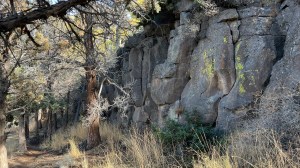[The following is a piece I wrote and sent to our local Parks staff, its advisory citizens committee, mayor and city manager…I got little back in response. I’ve developed a relationship with one of the city arborists and the park’s planner as well as have met several active neighbors interested in protecting Dry Canyon’s natural areas, several of whom have natural resources backgrounds with agencies. The City has no natural resource or botanical staff. There is no formalized friends group, nor is their an outreach and public education program that addresses these problems and the role of residents in their solution. Signage is minimal and inadequate. Their horticultural expertise would also seem quite limited. This is understandable as the City’s population has grown very rapidly in recent years. The need for such programs and an increase in expertise on staff will only increase as Redmond’s population continues to grow.]
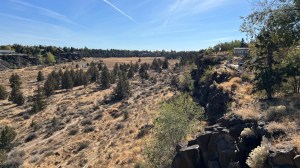
Redmond’s Dry Canyon looking south from the west rim on the Maple Street Bridge. The area in the immediate foreground burned this last summer.
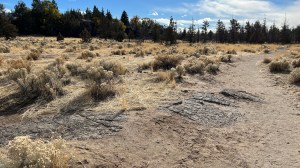
The canyon floor is variable, but as this pic shows, a solid layer of hardened lava underlies what soil is here, either blown in or washed in, a limiting factor of what can grow here. Rabbitbrush is a common and ubiquitous native pioneer.
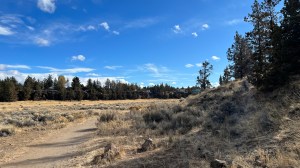
Match of the canyon floor is recovering from pasture use. These areas have relatively deep soils and are still transitioning with many weedy mustards, annual grasses like Cheat and planted grasses like Crested Wheat and Annual Barley. Native Bluebunch Wheat is scattered as are other natives. Gray Rabbitbrush, a native seral species has moved into much of it, but the weeds are dominant. Sagebrush and Bitterbrush are more at the edges and lower rim areas.

This section of bottomland, former pasture, probably burned not that long ago, has quite a colony of Rabbitbrush coming along, all it would appear of even age, suggesting a fire. Rabbitbrush are early colonizers and ‘prepare’ the way for natives to follow. This is just north of the Maple Bridge.
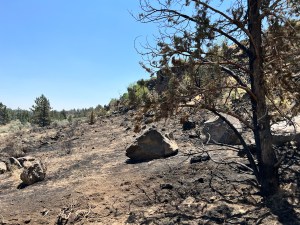
This area, maybe 5 acres, burned in July. It will be interesting to see what comes back and what the City may plant??? Fire kills Sagebrush and Juniper, while it seems to favor Cheatgrass. So far, April ’24, nothing has been replanted. The window for seeding is closed. Rabbitbrush can survive a burn. This site is unfenced, with very fragile soils and we’ve already observed new bike trails in it.
My wife and I are both recent returnees to Central Oregon having both grown up here. We are also frequent walkers in Dry Canyon, a place I spent many hours in playing and exploring as a kid in the 60’s. Redmond has changed a lot over the intervening years…change that continues apace as it grows. I’m not going to whine about the ‘good old days’ and things lost. Much of the change I welcome or at least accept (We did move back!), but population growth, in addition to bringing along economic vitality and stability, new and enriching opportunities and a more diverse community, increases the ‘pressures’ on the naturally limited assets that largely define the place and attract residents. I’m speaking here of the natural landscape, its features and the opportunities which it affords us for recreation and quiet enjoyment. Realtors were once fond of saying that no one is making new land, as a prompt for buying…it is a fixed and limited quantity. This limitation has profound implications for a growing population. We have far more people today ‘enjoying’ a limited, and increasingly over utilized landscape.
What do I mean? Whether a hiker, rafter, kayaker, skier, mountain biker, hunter, fly fisherman, quad rider or (fill in your choice), there are ever more people attempting to participate in those same activities across a limited landscape. This ‘use pressure’, on a specific landscape, tends to be higher within and nearby population centers. (We may be drawn to a region by its landscape and climate, but we tend to congregate in and near towns and cities which offer us the supports and conveniences we demand.) Those of us with a long enough memory in this place understand what this means for the quality of our experience. Newcomers, with only a short history, not so much…their ‘baseline’ for experience beginning at a later time, at a higher use level.
Our expectations can be quite different. Many have moved here in pursuit of a better life, to live in a place which affords them opportunities to pursue activities maybe they could only dream about before. Solitude becomes far more rare and we find ourselves waiting in lines, reserving times for river trips and hiking trails that today resemble trenches worn from heavy use and erosion. Rapid population growth accentuates these differences with longer term residents seeing their experience as degraded, while newcomers are simply grateful for the opportunity, but ignorant of the loss as more people press for their ‘nature’ or wilderness experience, the thrill of just getting ‘out’. We continuously redefine our expectations. There are qualitative differences in this changing world and it is not just about our experience…it is about the decline in health and associated beauty of the places in which we visit for those experiences. Over use can lead to trampled landscapes and the loss of native species which once made up the local community. Weeds encroach. The wildlife which intact landscapes once supported for many thousands of years, diminished, because it too is compromised. Places lose their uniqueness and richness as one place becomes much like any other. Place can become reduced to bare topography, the life it supported, degraded.
A few numbers describing Redmond’s population growth:
1960 – 3,340 My family moved here in ’61.
1970 – 3,721 Minimal growth as no sizable industry replaced the mills and agriculture, never large here, declined
1980 – 6,482 Redmond’s pop. nearly doubled that of 20 years earlier
1990 – 7,250 Redmond grew, but lagged behind booming growth in Bend
1995 – 10,585 est. The boom here began in earnest
2000 – 15,447 Population doubled in ten years to approx. 5 times the 1960 pop.
2005 – 21,476 An increase of just over 6,000 in five years
2010 – 26,215 Pop. increases by almost 11,000 in ten years, an almost 8-fold increase since 1960, even with the 2008 real estate collapse
2020 – 33,787 Pop. increase of 7,572 in ten years, over ten times its 1960 pop.
Est. 2023 – 39,463 an increase of 5,676…in 3 years.
A little more context:
1960 – Bend – 11,936 Mt. Bachelor Ski Resort began in Dec. ’58 with a single rope toe and one lift. The combined Shelvin-Hixon and Brooks-Scanlon mills had been the largest producer of pine lumber in the world.
Deschutes Cty – 23,100 the entire county had about 2/3 of Redmond’s current pop.
1970 – Bend – 13,710
1980 – Bend – 17,283
Moved to Bend in ’78 after college. Brooks-Scanlon mill closed in 1983
1985 – Bend – 18,450
We left its stagnant economy this year, a couple years before its new economy, heavily reliant on growth and recreation, began to take off
1990 – Bend – 23,694 its development/recreation economy grows rapidly attracting diverse businesses. It is no longer the dominant mill town
1995 – Bend – 30,630
Deschutes Cty – 94,100
2023 – Bend – 107,305
Deschutes Cty – 210,409
The shear number of people living here today, given the limited land resources that we have, would seem to argue for change. With roughly ten times the number of people, our public landscapes and Parks, are under far greater pressure. Those 3,340 Redmonites in 1960 had far less combined impact on public lands than do today’s 39,463 people. Add to this visitors from around the county and elsewhere and it would seem self-evident that our collective habits, preferences and activities need to be examined and modified, because landscapes, whether contrived in the form of Parks, or relatively undisturbed natural areas, have limited tolerance for use and abuse.
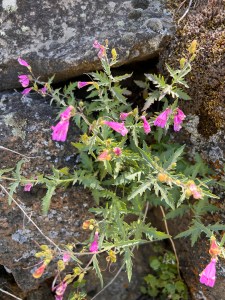
Penstemon richardsonii. I found this growing in multiple places from the rock of the canyon rim and in the tumble of basalt below, no where across the broad plain of the bottom.

Wax Current, Ribes cernuum, is common in the tumbled basalt below and forming the narrow shelfs of the rim.
I spent nearly 30 years of my working life as a horticulturist/land manager responsible for the care of Parks in systems elsewhere. Even encouraged and permitted activities, when enough users are participating, can push a landscape to the point of no return, beyond the abilities of paid staff to compensate for the wear and tear. Over the last year, walking through Dry Canyon, I have seen a decline in its overall health as unofficial trails proliferate and the trampled ground that border them, expands.

Penstemon speciosus, Royal Penstemon. Sadly, I’ve seen this beauty in only one spot in the entire canyon.
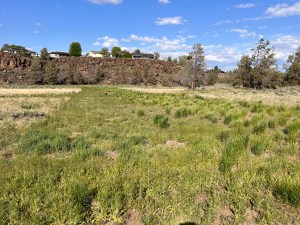
I was told that these ‘bands’, obviously manmade, are the result of fire lines carved out to limit a burn. These are full of a uniform mix of weeds and Crested Wheatgrass commonly planted by ranch managers. Most of the bottom land was once pasture and much or most of it is made up of weedy grasses and mustards
Redmond is located in a desert region, its landscapes, termed Juniper-Sagebrush Steppe, with a relatively short, predominantly dry growing season, having a precipitation pattern that rarely exceeds 10” annually, often 5” or less, desert conditions. There is a sparseness to our native landscapes that causes many to discount them. They are, counter-intuitively, fragile landscapes. Over use and abuse/disturbance, disrupts any natural landscape’s capacity to ‘repair’ itself, even with the support of Park staff’s active support. Our ‘desert conditions demand far longer recovery periods when left on their own, than do those in milder, wetter climates with longer growing seasons and a denser, layered, pattern of growth. Because of this, damage begins to accumulate at lower use levels from year to year.
The ‘open’ pattern of Steppe landscapes ‘encourages’ users to venture off trails as little blocks their progress. Simply walking, can result in the trampling of plants that might otherwise grow to fill in damaged areas. Common to areas like ours are surface ‘biological crusts’, composed of various lichens, mosses, fungi and bacteria, which help protect them from erosion and compaction by rainfall, in addition to aiding their recovery, but are themselves very sensitive to trampling, opening the way for common and invasive weeds. These abused/disturbed areas spread across the landscape, increasingly populated by the area’s most aggressive, and invasive, weeds. Invasives, are well adapted and are capable of spreading rapidly if left unchecked. They are already present in much of Dry Canyon. Dry Canyon is potentially an incredibly attractive asset to the community, but it is in the process of being lost as use patterns tip the scales in favor of dominance by invasives.
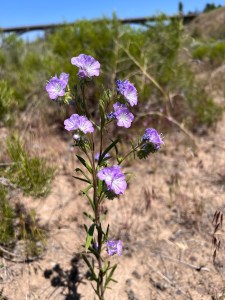
Threadleaf Phacelia, an annual, which should be everywhere throughout the canyon bottom, which I’ve only observed on a single site of a few hundred square feet.
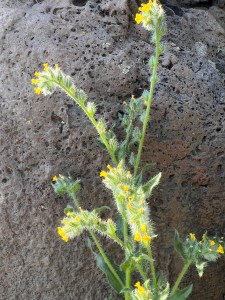
Fiddleneck, Amsinckia, a native annual with some toxicity to cattle, so a native often actively eradicated.
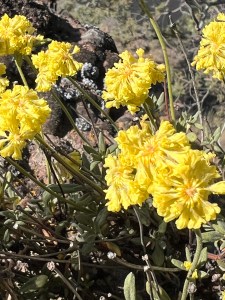
On of the many regional native wild Buckwheats, Eriogonum, perhaps E. sphaerocephalum, growing on the top of the canyon rim. These tend to occur on very thin, mineral, rocky soils…plants which should be common here, but are rare.

One of several common Erigerons, most people think of as Asters, but bloom spring to early summer rather than the fall. There are several species in the Canyon although their numbers aren’t very high.
This problem is not the Park system’s alone. As an organization, the nature of their work and the range of their responsibilities, has been changing and increasing with Redmond’s growth. Rapidly. Such change for any organization is difficult. Long standing policies and practices do not change over night. Nor does the organization’s capacities. There is always a lag. Organizations get pulled politically to meet new demands while being simultaneously held to old standards and expectations while staying within last year’s budgets. This is a community problem. As I attempted to describe above, activities which have become habitual, expected, even demanded, can become very destructive if not managed in some way as use pressure increases. 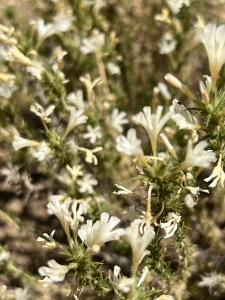
Being humans, we bridle against such management and restrictions, especially when such changes are ‘forced’ upon us, and doubly so when they begin to limit our preferred activities. But management of some sort becomes absolutely essential as population and use increase. It is unrealistic to expect local Parks staff to simply suck it up and ‘fix it’. That may work up to a limited point, but only with significant financial cost as more staff are required to more closely manage use and make effective ‘repairs’ to the landscape, not to mention the damage to staff morale which can devastate it (Think about it, being regularly brought in to ‘fix’ damage, we all knew would accrue, inflicted by users, seemingly indifferent to their impact, while asking little from them, no changes, no help. This leaves staff feeling disrespected and the work, ultimately pointless, a Sisyphean waste.) Please keep in mind that landscapes are living systems, not mechanical. It is better to think of this problem in terms of a health model. Once destroyed, you can’t just swap it out for a functional, new and beautiful one. ‘Repair’ of living systems/organisms require focus on that system’s health, supportive action, and the removal, or at least limiting of those factors which work to bring about its decline.
We could drop the goal of a native/natural landscape, for durability reasons as stated above, and redevelop the Canyon, in ways which are more tolerant of increasingly heavy use. But this sacrifices that which draws many of today’s visitors, and that conversion, is an expensive option. If done, where are local residents then to go for an experience with intact and functional native landscapes? Each loss applies greater use pressure on that which remains.
Even when redeveloped, the site will still have limits. When grass turf sports fields are over used, they also decline, requiring work and, rest, recovery time without use. A compromised field’s capacity to provide a safe, stable surface for play is lost. Again, regardless of its type, increases in use always requires increasingly intensive management. This leaves artificial turf. Living landscapes have limits.
Some will no doubt argue, why bother? Well, if you don’t care now, you may later when the entire Canyon is dominated by the worst weeds and blowing dirt, becoming a continuous source of ‘reinfection’ for all adjacent properties along the Canyon’s length. It will be a weed generator which exacts an annual cost from residents who must then ‘control’ the consequent weeds on their own property. Some protection from this is afforded by the canyon’s depth which will tend to limit weed spread, but many of the worst weeds will still move, carried by pets, vehicles and ourselves when we leave its confines. The four miles of Dry Canyon Park presents a management dilemma for Redmond. Either we manage it in such a way that protects its value as a natural/native landscape or we allow its accelerating decline.
People are not going to stop using it, nor should they. A considerable investment has been made to make it accessible. The only effective option which can protect and even enhance its natural features, involves training and educating both staff and community, so that we consider these landscapes’ health and make them a priority, both monitoring conditions and making effective changes in our use, management and care of these places, implementing measures in a timely manner. This will require a far more engaged public to assist.

The flowers of Antelope Bitterbrush, Purshia tridentata. These grow in scattered, dominant patches where the soils are ‘thinner’ often where the rock rises above the surrounding grade.

Desert Mariposa Lily, Calcohortus macrocarpus, one of our most showy and elegant wildflowers. These are scattered in small groups throughout the canyon north of Maple. In other area canyons these are often seen in the thousands, but not here. For several years while maturing their foliage looks very ‘grass like’. Where this occurs near trails I’ve found these ‘picked’ and later dropped by the trail. In some cases I suspect that the nearby bike riders have ridden through patches of them.

Small Leaf Creambush, Holodiscus microphyllus, occurs only in the tumbled basalt below the rims here, often with Gray Rabbitbrush as shown here.

The annual Coyote Tobacco, Nicotiana attenuata, which should be common, I found only in one tiny place. Many consider this a weed. It was once cultivated by some of the region’s native people.
In some places conservancies and trusts have stepped up and partnered with owners, public and private. Elsewhere coordinated, supportive ‘Friends’ groups have formed and play a significant role, politically, educationally and in terms of maintenance. Such an effort aids in developing wider public support, shaping a public which understands the demands and impacts of our chosen uses. Our use of public lands can either add to the problem or be a part of the solution. It’s a fairly simple concept, but one that may seem antithetical today given our polarized politics. Such a program requires an attitude which embraces reciprocity and gratitude, that when we pursue our activities and pleasures, we consider our impact and ‘cost’ to the landscape and community, so we simultaneously work to limit and ameliorate the damage that our use brings. It requires a recognition and acceptance of limits and shared responsibility.
There is another essential piece and that is the need for more Parks, whether Redmond continues growing or not, particularly for active uses. Overuse of Parks today is a direct indicator of the need for similar spaces to relieve the pressure. As I’ve already discussed, our local natural areas, are very vulnerable to active use. Of course no Park can tolerate much outright abuse or misuse, those will always require public education and enforcement/peer pressure. Signage itself can go only so far, although it is a necessary step. Posting signs everywhere of every possible infraction simply conditions people to ignore them. Informational signs are different in that they don’t demand anything of the user, they are ‘offers’ of information. The fact that so many people use Dry Canyon and that that use is at damaging levels right now, tells us that more natural areas, which offer similar experiences, are needed. This ‘void’ can’t be filled by limited pocket or smaller neighborhood Parks. Those serve other valid needs which will only increase as our population lives on smaller properties with little opportunity on them for active uses. People need to be active! We’re a mobile species and require movement. We also need access to nature to develop a healthy relationship with it.
Healthy, functional, natural landscapes can’t survive as isolated small plots. They require size to permit the countless cycles to be self-sustaining. Without this, our active management role is even larger, fulfilling the roles which a ‘healthy’ native landscape does for itself. Ideally these natural areas/Parks would be linked. In this way they can serve the additional purpose of corridors and reserves for wildlife, which can’t exist on isolated, small properties. That is a separate issue from my primary concern here, but the solutions are linked. As our population grows, consuming open space and natural landscapes, our demands for such spaces increase.
30, 40, 50 and 60 years ago our impacts as a population were far less, simply by far fewer people/users living here. Open spaces were nearer by. Many of those private spaces were still available to users, as long as neighbors were respectful of the owner’s wishes. This does not appear to be the case anymore. Neighbors are broadly excluded. In times past, with enough time, free of additional disturbance, landscapes could ‘heal’ themselves, bare soil could be repopulated with area ruderal species slowing the encroachment of aggressive invasive species…but not now. There are far more of us pursuing our chosen activities in a limited space. The disturbance is unrelenting. So we have a decision to make which is becoming ever more urgent. Delaying it brings with it a loss of opportunity and greater costs. It is not yours or your neighbor’s problem, it is our’s collectively. Like it or not, if we are interested in an effective solution, it is ours together. The solution is local. The conditions and requirements of its solution are as well. There is no cure-all, that doesn’t require a change in our own use. That solution lies in the nature of our use and the capacities and limitations of the place in which we have chosen to live. This is entirely ‘doable’ if we can come to accept our roles in both the problem and its solution.
As it stands now the north canyon is being preserved as a ‘natural area’, only there has been no extensive survey of what lives there, which weeds are on site, which weed populations are expanding and how the landscape is responding to public use and how it responds to current maintenance practices. Disturbed natural areas such as Dry Canyon, especially when surrounded by disturbed/developed sites, are subject to regular and routine ‘invasion’ by surrounding weed populations. Such sites cannot magically evolve back into a natural area, or something resembling one, without informed and coordinated intervention. The old relationships and cycles are broken. An effective maintenance plan requires an inventory and monitoring to evaluate the effects of use and one’s plan. A plan requires measurable goals, with clearly defined strategies and tactics. Everyone must be on the same page and working in a coordinated and supportive manner. Otherwise it is a hodgepodge and a plan in name only.
I see this as an opportunity to not just heal a valued landscape, but as an opportunity to begin to heal our community which, like so many around this country, have been suffering from the political divisiveness that surrounds us. Additionally, because we have grown so fast our relationships with one another are minimal and with that, likely our trust level. Of course the only way to improve that is to engage with one another on projects if value. How else does one get to know one’s neighbors and the place in which they live. Our landscape presents many opportunities readily apparent to newcomers, but with these opportunities, must come responsibilities, lest the landscape be diminished and that which brought so many here, lost. As with many problems the solution lies in the healing work of restoring community. This is our place, our community, our responsibility and if we want to heal either, we need to embrace the proper mindset, accept our collective responsibility, set our differences aside and ask ourselves what it is we want and how can we bring such a result about? Once we adopt such an attitude and begin the work, real and perceived problems can begin to resolve themselves along the way. There is no need to be discouraged or overwhelmed. All that is required of us is that we begin.

